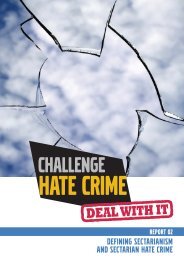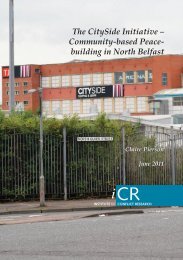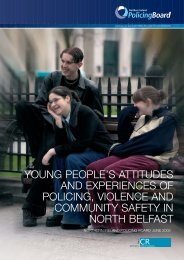Young People and Interfaces Report - Institute for Conflict Research
Young People and Interfaces Report - Institute for Conflict Research
Young People and Interfaces Report - Institute for Conflict Research
You also want an ePaper? Increase the reach of your titles
YUMPU automatically turns print PDFs into web optimized ePapers that Google loves.
YOUNG PEOPLE AND INTERFACES<br />
If you were going in on your own it would be different like (<strong>Young</strong> Catholic male).<br />
One young male spoke of his continuing reluctance to go in to the nearby Protestant area unless<br />
some of his new Protestant friends were with him:<br />
I would feel com<strong>for</strong>table going in with ones from the other side, but I wouldn’t feel com<strong>for</strong>table<br />
going in with (another Catholic young person in the group). Just because we are both Catholic.<br />
Even though nothing would happen, you’d just feel uneasy in case something happened<br />
(<strong>Young</strong> Catholic male).<br />
One cross-interface community organisation have been working in recent years to build<br />
relationships between young people. As a result of the engagement over the past two years in one<br />
interface location in North Belfast, a number of Protestant young people from one particular area<br />
reported feeling safer <strong>and</strong> would now use a local garage which they would not have done be<strong>for</strong>e as<br />
they had previously perceived it as ‘Catholic territory’. Indeed, some young Protestants now use a<br />
local drop-in centre which is also located in a predominantly ‘Catholic’ area. As such improved<br />
relationships between some local young people across the interface led to them asking one<br />
another questions about their culture or religion, a process which one youth leader felt was a more<br />
‘natural’ development over time rather than part of a more artificial attempt to bring young people<br />
together prematurely.<br />
While these young people now used the shop at the garage on the Antrim Road in the evenings<br />
with their friends, again other young people who traversed the interface tended to do so as part of<br />
a more <strong>for</strong>malised youth group or with school, <strong>and</strong> they would not feel as com<strong>for</strong>table doing so with<br />
their friends on their own initiative. At various times some young people also felt very aware of<br />
which parts of the area would be ‘off-limits’ <strong>for</strong> individuals from ‘their community’, <strong>and</strong> felt they<br />
could ‘tell’ someone’s community background based on how they moved around an area:<br />
That’s what I am saying walking up to the Antrim Road, that’s how you know if you’re Catholic<br />
or Protestant, what side of the road you walk on…If you walk on one side you are Protestant if<br />
you walk on the other you are a Catholic (<strong>Young</strong> Protestant male).<br />
You’d stay on this side of the doctors (<strong>Young</strong> Catholic male).<br />
These issues in terms of being able to ‘tell’ someone’s community background impacted upon<br />
which services <strong>and</strong> facilities some young people felt they could access.<br />
3.6 Accessing services <strong>and</strong> facilities<br />
The restricted movement associated with living at an interface impacted upon the majority of young<br />
people, <strong>and</strong> it seemed to be the case that this impact was particularly significant <strong>for</strong> young people<br />
from what could be termed enclave interface communities such as Suffolk or Short Str<strong>and</strong>. For<br />
young males in Suffolk in particular, their dentists <strong>and</strong> GPs were all in Dunmurry <strong>and</strong> Finaghy <strong>and</strong><br />
very few services in wider nationalist West Belfast on the Stewartstown Road <strong>and</strong> beyond were<br />
utilised. Rather than using the nearest leisure centre which was situated in Andersonstown, they<br />
spoke about travelling to Lisburn:<br />
We are surrounded basically...We can’t go to certain places that the likes of them can. They can<br />
go up <strong>and</strong> round us. They don’t necessarily have to walk down Black’s Road, it’s the quicker<br />
option, but they can walk round it (<strong>Young</strong> Protestant male).<br />
22






